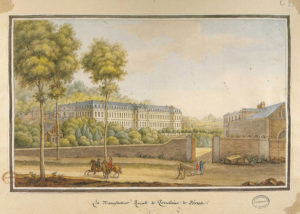Cité de la Céramique à Sèvres, 1740
French Porcelain in the Eighteenth Century
Porcelain was a relatively unknown commodity in seventeenth-century France. Examples of both Chinese and Japanese porcelain could be found in royal and aristocratic collections, but because of their cost, these objects were available only to the highest levels of society. Before the last decade of the seventeenth century, there was no domestic production of porcelain in France, and faience (tin-glazed earthenware) was the most common type of ceramic.
It is not surprising that the first porcelains produced in France were made at faience factories. Experiments in a Rouen faience factory owned by the Poterat family resulted in some of the earliest examples of soft-paste porcelain made in France. Soft-paste porcelain was a type of artificial porcelain that lacked the ingredients found in true or hard-paste porcelain. One of these ingredients, known as kaolin, was not discovered in France until the second half of the eighteenth century, and all French porcelain produced before 1770 was soft rather than hard paste.
